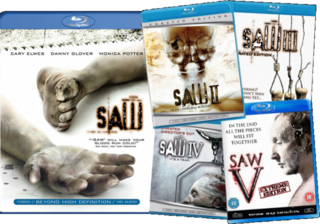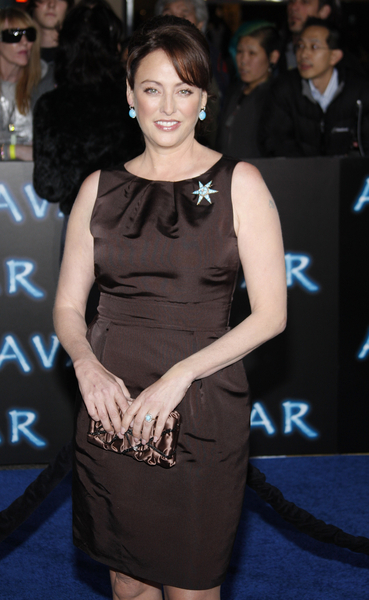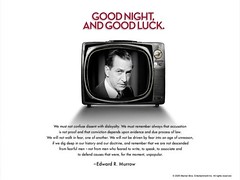About a month and a half ago Jeopardygirl--who thinks I don't have symbols of childhood innocence--made an entry to her blog, of her Top 10 Contemporary Canadian Films (she's Canadian). I thought I should come up with an American version.
I made a rough list or two, but never got around to actually writing the post until about a week ago when I wanted to try to write something, started this and have been hoping to finish it up.
First of all, you may notice, I have played it a bit fast and loose with what constitutes an "American" film, which is my wont. For the record, my rule of thumb was: At least 50% of the financing had to have come from America.
(That is why Fellowship of the Ring is on the list, representing the whole Rings trilogy--the second two were split three ways between New Zealand, the US, and Germany.)
Jeopardygirl defined "contemporary" as within the past 20 years, my list cuts it down to between 10 and 15 (not for any particular reason, it just worked out like that).
If you've been reading this blog long I don't think many of my choices will surprise you, insofar as to what movies I like. But I hope I've said more a few or more new things about why I like them. You be the judge.
(You'll also notice there are no numbered rankings. This is deliberate)
Hellboy.
There have been a lot of great comic-book films these past years--Spider-Man 2, Iron Man. But in my heart I think this is the best.
Unlike the rest of the illustrations in this post, this isn't an image from the film:

But come on--how adorable is that?
Maybe it doesn't hurt that it's the one whose comics I was least familiar with.
It's a story about faith (despite the name) and imagination.
I didn't like the Golden Army sequel as much as most critics (neither did most moviegoers), because I felt it failed to build on the possibilities of the first.
Good Night. And, Good Luck.
Exquistely shot through with historical context.
Lost in La Mancha. Really representing all Terry Gilliam movies of the past 10 years including Tideland, and probably Doctor Parnassus
 once I see it.
once I see it.See, here I have a problem. I'll get to it in a minute.
If I'm talking about movies, I have to talk about Terry Gilliam. He is my favorite director, what else do you want to know?
Like the makers of the Lord of the Rings films, Gilliam knows how to have size without sacrificing acting--or writing.
According to every report I've seen, he respects writers and their role in creating his movies.
I have always assumed that coming up with five writers and performers as contentious as his Python workmates had something to do with this.
Getting back to my "problem," with including any of his recent films on this list, it is simply this: Although he was born and raised in America, he emigrated to Great Britain in the '60s and has lived there ever since.
(A few years ago he even became a British citizen, giving up his US citizenship. I think George W. Bush was the last straw).
Even so, by that rule of mine (50% financing), some of his films from the '70s through '90s might count as American. But the last one that did was Fear and Loathing in Las Vegas, in 1998. Since then his movies have been heavily or wholly financed outside of the States.
(And to me, that's not one of his better films. It's not bad--I put Terry Gilliam movies in the category of things where there is no such thing as bad, there's good and there's better, but there's no bad. This was not one of his better films.)
So, taking all of the above into account, how can I rationalize putting Tideland, or any of his movies, on a list of top contemporary, American films?
Like this.
A continuing theme of Gilliam's movies has been his response to growing up in America in the '40s, '50s and '60s. He was driven to create fantastic worlds in response to the catastrophe he saw in the ordinary world around him.
It's why it's so incredibly fitting that his attempt to film a story of the man who tilts at windmills, as we see in the Lost in La Mancha documentary, should've been the one to fall apart on him like Humpty Dumpty.
Gilliam, I believe, wanted to escape into "fairy tales," but he also knew that could never totally work, and so he left himself notes in most of them. (When he forgot, or tried to, he made The Brothers Grimm, which is also merely a "good" film.)
Tideland, no matter how "twisted" it was proclaimed by some--ok, most--idiots at the time of its release, was a love letter to childhood innocence. Where exactly was Gilliam an innocent child?
My point being: No matter where he lives, where he pays taxes, or where the money to make his films comes from, Terry Gilliam's eyes are American.
And I couldn't be prouder.
Now...
You knew we'd get here sooner or later:
Saw; including all sequels. I am a fairly unabashed lover of most things Saw, because at their best they've asked more of their writers, actors and audience than any other comparable series.
I am a fairly unabashed lover of most things Saw, because at their best they've asked more of their writers, actors and audience than any other comparable series.
They did this (among other ways) by giving their central character John Kramer, sometimes known as Jigsaw, just that: Actual character. As opposed to, say, the vicious dog on two legs that is Jason Vorhees.
What's weird is, by the filmmakers own admission, a lot of that has been luck. Actors like Shawnee Smith and Tobin Bell, who have become important to the series (in Bell's case, damn near indispensible--he plays John Kramer), were cast before anybody had any idea what would be asked of them in the sequels.
These movies, when they're written by writers and played by actors who take their work and their craft seriously, have actually let us see the effect that the Jigsaw character has on others.
Some of this is arguably for good, most of it for evil, but they let us see it--and they let him see, and be affected by that as well.
For these and other reasons, at their best, the sequels have actually built on each other rather than just turning into bloodier and bloodier rehashes. Even the least of them.
Although, this--along with a lot of what I've praised above-did start to slip a little by Saw IV. And a lot in Saw V, which is the least creatively succesful film in the series to date (good start, good ending, one good scene in the middle--whooooole lotta filler).
VI was a much better, even choice in many ways, film; as I've noted previously, it received the best reviews since the original. Still, I'm not exactly sorry to say that word is next years Saw VII will be the end.
BTW...this is another place where you could question the status of these movies as "American" films. Saw was created by a couple of Australians, and after the first movie (which filmed in LA), all the sequels have been filmed and co-financed in Canada.
(until VI, which actually split its money between four countries...which might explain why VII was fast-tracked: Less risk, to more financers...plus the fact that no film in the series has been unprofitable)
Moving on (I heard those of you who said, "Thank god...")
The Lord of the Rings: The Fellowship of the Ring
Okay. I granted up front, including this as a contemporary American film is arguable--roughly half of the stars are from England or Australia, the director and co-writers are from New Zealand, where it was also shot.
But, it was co-financed with American money. And come on, what was I going to do, leave it out?
This is a movie that schooled Lucas--or should have--on how to make an epic without sacrificing storytelling. (I've regained much of my interest in Lucas' contemporary films-the prequel trilogy-thanks to seeing them again through my nephew's eyes. But, you'll notice that none appear in this list.)
I gotta give Fellowship mad props.
Now I want to talk about my two "animation directors of the decade-plus," Brad Bird and Andrew Stanton. Bird made The Iron Giant, Ratatouille and The Incredibles. I like The Incredibles and love Ratatouille, but Iron Giant is better than either of them.
It's a film about which I always tell people: If you read comic books when you were 10...you're gonna cry when you reach the end of this movie.
Andrew Stanton made Finding Nemo and Wall-E (as well as co-writing the Toy Story films and Monsters, Inc).
 Nemo is still, for me, the high-water mark (tee hee) against which all other are judged, and Wall-E made confident strides in animated storytelling whilst (and at the same time) never, ever losing heart.
Nemo is still, for me, the high-water mark (tee hee) against which all other are judged, and Wall-E made confident strides in animated storytelling whilst (and at the same time) never, ever losing heart.
(Strange to say, I didn't realize until just when I was writing this draft of this long-in-the-works post how much the broad strokes of Stanton's Wall-E resembles Bird's The Iron Giant, another fun movie about a robot, with heart.)
As I say, I liked both The Incredibles and Ratatouille when I first saw them in the theater, but on subsuquent viewings I've cooled on The Incredibles while my affection for Ratatouille has only grown.
It's some kind of genius.
Animation is one of the few things in which I actually have a lot of national pride. I feel the best animated cartoons are and have always been made right here in America.
For the past 10-15 years or more, all the best American animated cartoons with but one exception have been made at Pixar.
As for that exception, it was Iron Giant (good guess) and Pixar themselves liked it and Bird's other work enough to bring him over to work there. It's top of the list; I consider it the last great "2D" animated film. (I hear good things about Princess & the Frog, but I haven't seen it)
Gone Baby Gone For the love of god, see this movie.
For the love of god, see this movie.
It is the story of one man's struggle to do what he thinks is right, within a moral nightmare, and it is a good fucking movie about people, including us, who have lost their way.
I hate to think people didn't see it because Ben Affleck directed it.
He made a heartbreaking film that's at least as good as Mystic River and even better (yes, better) than The Departed.
Sideways. I think Sideways is a good movie despite (because of?) the fact that it is at times a very uncomfortable film for me to watch. It's uncomfortable because, like Paul Giamatti in the movie, I like to close my eyes to reality.
I think Sideways is a good movie despite (because of?) the fact that it is at times a very uncomfortable film for me to watch. It's uncomfortable because, like Paul Giamatti in the movie, I like to close my eyes to reality.
My standard line, tho, is that it could've been made for me: I'm a frustrated writer who's been in love with Virginia Madsen since 1985.
And she's wonderful in it.
As an aside: Madsen is one of I don't know how many actresses, but it can't be more than a few, to succesfully "graduate" from the sexpot roles she was doing 20 years ago.
Not that she's not still hot (look down). Actually, she should be a role model in how to use things like Botox sensibly.
But in the mid-'90s, you could've been forgiven for thinking she was going to have-well, the career that Sharon Stone's had in the past decade....


2 comments:
Just to clarify: "contemporary" for Canadian cinema has to have such a wide year range because our filmic output (aside from Hollywood North productions) is so much lower.
Also, my restrictions on content were much stricter than yours vis a vis financing, crew, cast and distribution. This is not to cast aspersions on your list (it's as good as I've seen), just to be specific about what can be considered Canadian. We lose so many talented people to Hollywood, it would be extremely easy to call a film starring Mike Myers as Canadian, but let's be honest, it wouldn't be ethical to do so.
:)
Hollywood North and Twisted Pictures (Producers of, yes you guessed it...)
Post a Comment